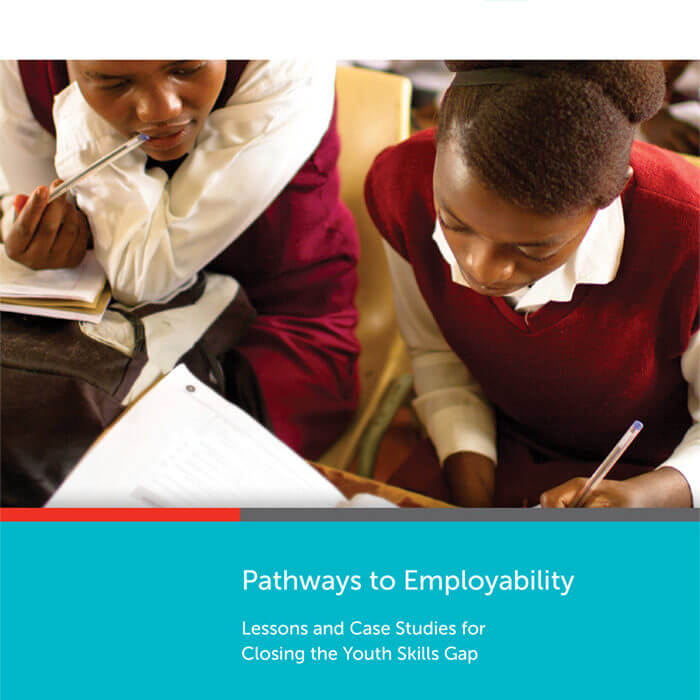The Challenge
By 2030 the global labor force will see an increase of 600 million to 3.5 billion, with sixty percent of this net increase taking place in South Asia and Africa. Unless secondary education trends double or triple, one billion of the 3.5 billion will lack secondary education.
While many countries in these regions have raised secondary education as a priority, the explicit link between secondary education and skills for employment is still absent in many national education systems — a significant problem given the fact that most youth entering the workforce will not obtain any education beyond the secondary level. In addition, an increasingly interconnected global economy and rapid evolution of traditional labor roles means that conventional ways of delivering skills for employment are becoming less relevant and responsive to workforce demands. There is therefore an urgent need to reevaluate the skills needed for employability in the 21st century economy, and to find innovative models to deliver these skills to students.
The Opportunity
Global acknowledgement that poorly performing secondary education is at the root of high unemployment has created momentum toward a better understanding of how that might be changed. Increasingly, industries are cooperating with education and training providers to ensure that students are receiving the skills training that will prepare them for the workforce. However, the overall gap between what students are currently learning at the secondary level and the skills they need to gain and retain employment is still largely undefined.
Understanding this “skills mismatch” and identifying ways to overcome it will provide educators, policymakers, donors, and other stakeholders the tools to better prepare youth for the 21st century workforce.
Our Work
Through the Innovative Secondary Education for Skills Enhancement (ISESE) project, supported by the Rockefeller Foundation, Results for Development (R4D) identified the skills required for work in the 21st century economies of Africa and Asia, and explored innovative models of delivering these skills to youth of secondary school age. The project ran from December 2011 to December 2013.
In-depth research: We worked with strong research partners in Africa and Asia to produce twelve background studies that explore employer needs and existing curricula systems, and identify existing innovative skills delivery models. R4D also ran a competition to identify additional innovative models of skills delivery in our 12 focus countries. Based on findings from these background studies and competition results, R4D has produced two synthesis reports on skills for employability in the 21st century.
Convening with experts: A reference group comprised of experts in the fields of skills development and education was formed to provide guidance over this research. In July 2012, R4D gathered this reference group and a wider panel of advisors, including representatives from multilateral development banks, international foundations and IGOs, business and technology leaders, policymakers, and academia, to review and discuss the preliminary research findings at the ISESE Phase I Review Meeting.
Regional dialogue: R4D and partner NUEPA held the ISESE Asia Regional Skills Symposium in New Delhi, India on January 9-10, 2013. During this symposium, a mix of policymakers, researchers, employers and program implementers from South and Southeast Asia discussed policies and approaches that strengthen the quality and relevance of the skills delivered at the secondary level. Key themes and lessons identified during the course of the symposium, as well as priority areas for action identified by region-specific discussion groups, can be found in the symposium’s Meeting Summary.
At a meeting in Nairobi In August 2013, R4D once again brought together policymakers, innovators, and researchers to identify important lessons for how to effectively structure and support successful and sustainable skills delivery models in Africa.
Detailed analysis and dissemination: The second phase of the ISESE project identified exactly how innovative models address the critical skills gap identified in our background research, and how they could be potentially scaled up or replicated to increase workforce readiness. With this in mind, we selected six successful models—four from Asia and two from Africa—and conducted a deep-dive study on each, looking at factors such as program design and goals, context, cost, sustainability, and impact.
In addition, we also focused specifically on models that skill youth for the digital economy and explored promising programs that are training youth for employment in this sector.
What next? There is a pressing need to discover, operationalize, and propagate innovative solutions that promote youth employability and close the skills gap. R4D looks forward to engaging with you to effectively leverage our research and expertise in this area, and seeks to collaborate with interested parties to promote skills for employment.
Click the links below to download the Phase I and Phase II reports and the digital economy study. For further information or a hard copy, please contact Shubha Jayaram.














